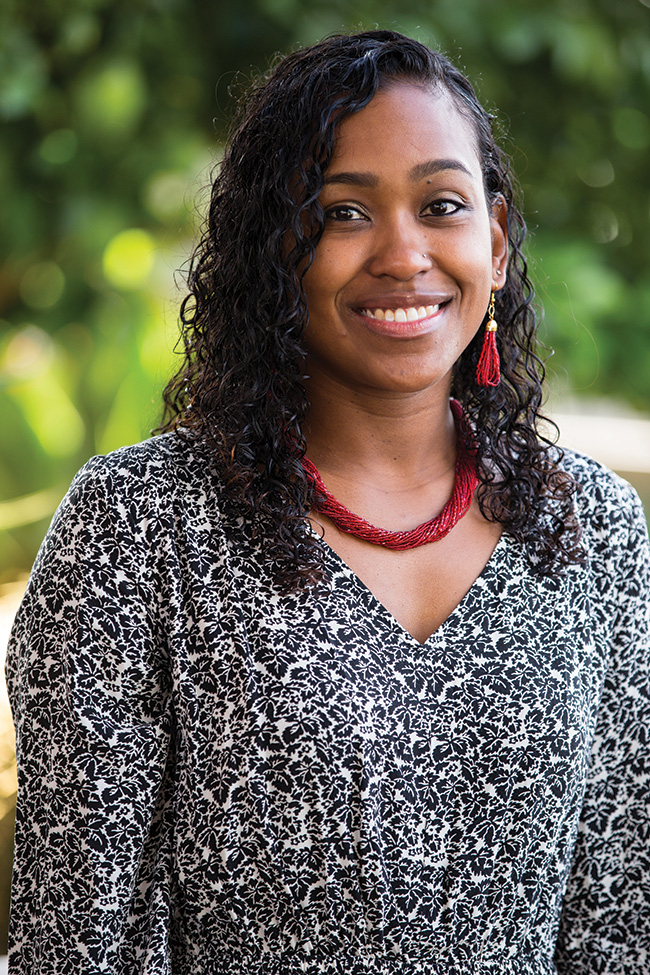Faculty
Mixed Meaning
Alyssa Newman, Hixon-Riggs Early Career Fellow in Science and Technology Studies, describes her research
Everyone has a little bit of Neanderthal DNA. We know this because a new method for analyzing the human genome resulted in the recent discovery by Princeton researchers that African individuals carry a stronger signal of Neanderthal ancestry than previously thought. They join people of Asian and European descent whose ancestors interbred with Neanderthals after migrating from Africa. Later generations spread these genes around the world.

What is the impact of this Neanderthal DNA? Is it good or bad for the gene pool? Does it matter that some populations have slightly more of this DNA than others? These questions and more made for a lively discussion in the classroom of Alyssa Newman, Hixon-Riggs Early Career Fellow in Science and Technology Studies and a sociologist of race and ethnicity. The topic could not have been more ideal for her class Scientific and Popular Perceptions of Racial Mixing: From Hybrid Degeneracy to Hybrid Vigor.
“We discussed how we understand Neanderthal human hybridity and mixing,” says Newman, who began teaching at Harvey Mudd in 2018 and concludes her appointment this year. “It brought up conversations about hybrid degeneracy and hybrid vigor, about perceived differences between these racialized populations, like how are their genes different from one another? The discovery that Africans have Neanderthal ancestry, too, throws a wrench into the ways in which we’re constantly trying to differentiate populations by race.”
Other recent scientific discoveries related to human reproduction have given Newman and her students plenty to talk about. In 2018, when she taught Technology and Human Reproduction, news surfaced about twin girls born in China who had their genes edited in order to provide HIV resistance. The procedure used CRISPR, a programmable scalpel that “cuts” a particular DNA sequence and replaces it with a new one. The experiment on the twins raises questions directly related to impact of work on society, a concept that is at the heart of an HMC education.
“It’s been a great field to be in with so many developments constantly changing the ways we’re thinking about things,” says Newman. “Teaching science and technology studies in a liberal arts setting is particularly exciting because the reproductive technologies we discuss in class are the technologies or tools that some students are working on in lab.”
Newman earned a PhD in sociology from the University of California, Santa Barbara, and has spent the past two years at HMC as a postdoctoral fellow in the Department of Humanities, Social Sciences, and the Arts. In addition to her teaching duties, she’s had the opportunity to organize two HMC events, a panel highlighting Puerto Rican scientists (Hixon-Riggs Program) and a conference (Hixon Forum) on reproductive technologies and reproductive justice that gathered scholars to discuss issues of equity, access and ethics.
It wasn’t until she took a class on racially mixed people in the U.S. as a college junior that Newman realized she could become a researcher studying people like herself (her father is African American, and her mother is Filipino and Portuguese). Newman began as a sociologist in the field of race and ethnicity, specifically focused on multiracial populations. Her dissertation, a study of the multiracial collective identity in California, allowed her to investigate the state’s multiracial population, the largest in the U.S. I was interested in how mixed-race people have interacted with each other and what racial categories they affiliate with and what experiences they find meaningful.”
Her study in this area led to deeper questions about family, specifically about parents from different races. She wondered if people found it important to associate with some or all of their racial backgrounds. “I wanted to study what that means when they have a child and when partners of a different race, especially, want to share multiple backgrounds with them. How does this identity become important through the next generations?”
One of her studies involves five interracial lesbian couples. The resulting paper—“Mixing and Matching: Sperm Donor Selection for Interracial Lesbian Couples”—published in the journal Medical Anthropology, describes how these couples experience a “bio-matching tradeoff” in their search for a gamete donor. As gamete banks tend to have few donors of color, Newman wanted to learn what couples do when they can’t find a donor who represents them. “Several couples wanted to use the same donor for both children because having a biological sibling relationship was important to them, so they had to choose which is more important: matching the donor to the parent and not having biologically related children or using the same donor both times and having racially different kids. I wanted to know if the biological relationship between the two siblings is something that they prioritize more than the shared racial background.”
Newman intends to continue her study and to interview the couples again about their new famies and the complex decisions they made.
In her Racial Mixing class, Newman’s students are reading Nella Larsen’s Passing (about Black women whose light skin allows them to “pass” as White) as well as texts from the early 1920s about racially mixed persons trapped between two worlds. They will study discourses about racially mixed characters represented in popular culture and do final projects on a variety of topics, including, comparisons of race and sexuality as binary social constructions, and stereotypes about the multiracial experience. Students will submit these final projects as papers, zines, podcasts and videos.
In her research and teaching, it is Newman’s hope to illuminate the similarities—beyond the Neanderthal ancestry—among all people.